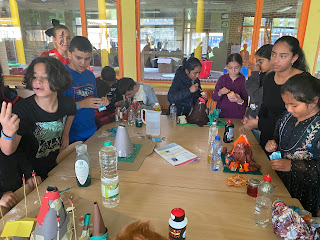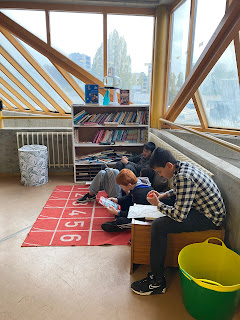I also do my internship in primary education at the same school "De Puzzel Basisschool Runkst", which is located in Hasselt. With this level, I am placed in the last grade (level 6) in that school. Like the pupils in pre-primary education in terms of diversity, this class consists of 17 students of which only 7 of them are girls. More than half of them are of South and West Asian descent and the rest are of Caucasian descent. English is not taught yet in grade 6 of primary level; however, most students in that class can communicate in English and some of them can do really well.
Since English is not included in the curriculum in this grade yet, I have planned to spend most of my time observing how the students are taught, materials and lessons are used and the teacher interacts with her students. Besides, I also help the classroom teacher check and mark the students' answers during the lesson and give a helping hand whenever needed.
At the same time, I would also like to challenge myself in a foreign country. Therefore, I have chosen to lead an activity and teach two lessons. The first activity is "Quizzes" about things the students like such as animals, flags, celebrities, etc. I use two interactive platforms (Blooket and Quizizz) to carry out this activity. The second lesson is about Khmer Literature and the last one is about origami (A jumping cat).
Before I give out my first activity, I have some time to observe the class to see how I should treat the students and to know what the rules in the classroom are. However, what I have observed and even the classroom teacher gives me the absolute authority to control the students, I have not executed that power really well, especially during the last lesson in which I teach the students to fold a jumping cat. It was kind of loud that the classroom room teacher had to step in to quiet the student down.
For the first activity in which the students have to use a device to play some quizzes with Blooket and Quizizz goes really well. The students have a lot of fun playing with those two platforms. Even the classroom teacher herself also learns a lot from using those interactive platforms.
The most difficult lesson I feel I have not done really well is teaching my Khmer Literature. Firstly, I have a really broad objective and too many tasks for students to do. As a consequence, I do not achieve my goal. In addition, I get shocked when two students explicitly show that they are no longer interested in my lesson even though I have noticed and preconceived that the classroom teacher normally lets her students do whatever they like to do or hold if they do not disturb their classmates while she is teaching.
The last lesson, in which I have to teach them to fold a jumping cat, goes really well except for the fact that I do not shush the students. Consequently, the class becomes too loud; thus, the classroom teacher has to intervene.













